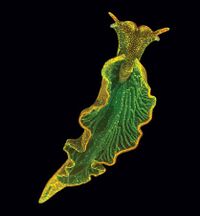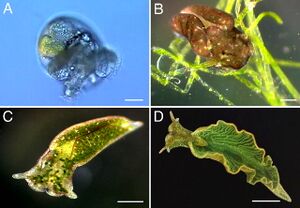Elysia chlorotica
Introduction

Elysia chlorotica (or the eastern emerald elysia) is a marine Gastropoda species in Plankobranchidae family, and clade in Sacoglossa. Elysia chlorotica (E. chlorotica) have been found in salt marshes and ponds off the coast of the eastern states and in Nova Scotia, Canada. [1] The clade that E. chlorotica belongs to are sea slugs that are able to perform photosynthesis, known as "solar-powered sea slugs", which is unique among other sea slugs[2]. Species in this clade have been found an unusual phenomenon called "kleptoplasty", which means they can use living chloroplast where they get from algae for their own using. After they have been first feeding on algae, the chloroplast they obtain from algae will be preserved in their special digestive system and use for photosynthesis. The chloroplast remains in E. chlorotica will turn them into bright green.
Life cycle and Morphology

Elysia chlorotica is bilaterally symmetrical like a real leaf. The adult individual are around 3~5 centimeters long. An Elysia chlorotica has four stages of development: larval, juvenile, young adult and mature adult stages, which can be distinguish by its morphology and coloring.
Larval Stage
E. chlorotica's life start with veliger larva. They have a shell and ciliated vellum used for swimming and obtain food.[3] On the early stage, E. chlorotica larva feeds on small phytoplankton in the ocean water. Larva has two eyespots on two side of its mouth. The Ciliated vellumon at the outside of the mouth can constantly bring food into the digestive extract to the stomach. Then, food will be sorted and filtered in this process before it move on to the digestive gland. In digestive gland, nutrients in the food will be absorb by E. chlorotica.
Juvenile Stage
During juvenile stage, newly hatched E. chlorotica are usually translucent brown, with few red spots on their bodies. This stage remains until the initial feeding on algae,Vaucheria litorea.
Young/Mature Adult Stage
The E. chlorotica obtains chloroplast from the algae, preserving in its special digestive tract. The presence of chloroplast gradually turns the body color into bright green, and lost red spots.Elysid refers to the adult slug’s leaf-like shape which is caused by two large lateral parapodia on either side of its body. This morphology is beneficial as both camouflage and allowing the slug to be more efficient at photosynthesis. Other members of this family are distinguished by their parapodia in addition to bright coloring.
Kleptoplasty
Kleptoplasty is a special symbiosis behavior that the chloroplast uptake by algal prey can remain temporarily functioning in the organism, which allows an animal doing photosynthesis like plants. The Species in the clade Sacoglass (such as E. Chlorotica) have this ability. Recent research suggest that kleptoplasty can be obtained through lateral gene transfer from algae to the sea slug. (Cesar.V) The symbiotic chloroplast in the organism remains functioning after 8 months’ starvation (even it turns yellowish); it is the longest-lived symbiosis chloroplast ever reported. Scientists suggested three possibilities to explain this phenomenon: (i) All plastid and nuclear-encoded chloroplast proteins are remain stable in the organism. (ii) At the initial stage of symbiotic evolution some algal nuclear genes may have been transferred into sea slug’s nuclear genome. (iii) The symbiotic plastids can live individually and remain functioning without the exist of the algal cell nucleus and cytoplasm (Cesar.V). By isolating E. chlorotica DNA free of interfering mucus(Rumpho et.al 13), researchers concluded the algal chloroplast gene has been actively transcript and translate in the sea slug, such as rbcL, rbcS, psaB, psbA, and 16S rRNA had been found in the organism after months’ starvation[4]. RbcL gene, which encode Rubisco LS, has been found in E. chlorotica DNA; Rubisco LS protein is also presence after two month’s starvation. PsbA Genes were remain constant until 4 months of starvation and start to decline. The 16S rRNA gene stays at a constant level from start to finish. RbcS is also remains at a steady level. These genes are directly engage in chloroplast encoding which indicates E. chlorotica can constantly encoding new symbiotic chloroplast using gene information even without food (chloroplast) source. Furthermore, the transcription and translation of chloroplast occurred in the situation where plant nucleocytoplasm is absent; which means the regulation of chloroplast gene expression is taken by sea slug’s nucleus and cytosol; or completely regulate within the symbiotic plastid genome. However, chloroplast in E. Cholotica is not inheritable, the acquisition, usage and maintenance of kleptoplasty will appears on sea slug after they been feed on Vaucheria litorea.
Feeding
Elysia chlorotica feeds on filamentous algae, the most well known type is Vaucheria litorea. When a E. chlorotica is eating, it will punctures the cell wall with its piercing teeth.Then, it holds the algal strand and sucks up the chloroplast and other cells insides the algae. E. chlorotica will store the chloroplast in their digestive system and using them for photosynthesis.
References
- ↑ Rumpho, Mary E., Elizabeth J. Summer, Brian J. Green, Theodore C. Fox, and James R. Manhart. 2001. “Mollusc/Algal Chloroplast Symbiosis: How Can Isolated Chloroplasts Continue to Function for Months in the Cytosol of a Sea Slug in the Absence of an Algal Nucleus?” Zoology 104 (3-4): 303–12. https://doi.org/10.1078/0944-2006-00036.
- ↑ Vries, Jan de, Gregor Christa, and Sven B. Gould. 2014. “Plastid Survival in the Cytosol of Animal Cells.” Trends in Plant Science 19 (6): 347–50. https://doi.org/10.1016/j.tplants.2014.03.010.
- ↑ Blanchet, Chelsea. 2011. “Elysia Chlorotica.” Animal Diversity Web. 2011. https://animaldiversity.org/accounts/Elysia_chlorotica/.
- ↑ [Mujer, C. V., D. L. Andrews, J. R. Manhart, S. K. Pierce, and M. E. Rumpho. 1996. “Chloroplast Genes Are Expressed during Intracellular Symbiotic Association of Vaucheria Litorea Plastids with the Sea Slug Elysia Chlorotica.” Proceedings of the National Academy of Sciences 93 (22): 12333–38.]
